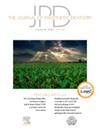一项长达三十年的回顾性研究,研究对象是牙科学校环境中单体和夹板种植体支撑牙冠的成功率和存活率。
IF 4.3
2区 医学
Q1 DENTISTRY, ORAL SURGERY & MEDICINE
引用次数: 0
摘要
目的:本回顾性研究的目的是评估牙科学校提供的单体和夹板种植牙冠的成功率和失败原因:使用axiUm牙科管理软件程序和纸质病历,对1989年9月至2020年1月期间提供的所有单体和夹板种植牙冠进行评估。记录了成功率、存活率、失败率以及失败原因。对单一种植体和夹板种植体的存活率进行了卡普兰-梅耶尔存活率估计和相关的 P 值、生命表分析以及对数秩检验:30 年间,共提供了 678 个种植体支撑冠(586 个单体冠和 92 个夹板冠)。在这些牙冠中,有 17 个(2.90%)单体牙冠和 5 个(5.43%)夹板牙冠失败,其中单体牙冠(64.7%)和夹板牙冠(80%)的失败大多是修复失败,而不是生物失败。共有 371 个单体(63.3%)和 46 个夹板(50.0%)种植体牙冠完全成功,215 个单体(36.7%)和 46 个夹板(50.0%)牙冠存活,但出现了一些并发症。种植体支撑冠的总存活率为 96.8%。单一种植体和夹板种植体牙冠的存活率分布没有明显的统计学差异[χ2(2)=1.285, P=.257]:单一种植体和夹板种植体支持的牙冠成功率都很高,存活率也相似。最常见的并发症原因也相似,单冠和夹板冠最常见的并发症都是冠的脱粘和螺丝松动。本文章由计算机程序翻译,如有差异,请以英文原文为准。
An up to thirty-year retrospective study on the success and survival of single unit and splinted implant-supported crowns in a dental school setting
Statement of problem
Studies investigating the survival of implant-supported crowns provided in a dental school setting are sparse.
Purpose
The purpose of this retrospective study was to evaluate the success and reasons for failure of single unit and splinted implant-supported crowns provided in a dental school.
Material and methods
Using the axiUm dental management software program and paper charts, all single unit and splinted implant-supported crowns provided between September 1989 and January 2020 were included for evaluation. Success, survival, and failure were recorded as well as reasons for failure. A Kaplan-Meier survival estimate with an associated P value, a life table analysis, and a log-rank test comparing the survival of single unit and splinted implant-supported crowns were performed.
Results
Over 30 years, 678 implant-supported crowns (586 single unit and 92 splinted) had been provided. Of these crowns, 17 (2.90%) single unit crowns and 5 (5.43%) splinted crowns failed, with most being prosthetic failures for both single units (64.7%) and splinted (80%), rather than biologic failures. A total of 371 single unit (63.3%) and 46 splinted (50.0%) implant crowns were a complete success, and 215 single unit (36.7%) and 46 splinted (50.0%) crowns survived but had some type of complication. The overall implant-supported crown survival rate was 96.8%. The survival distribution of the single unit and splinted implant-supported crowns was not statistically significantly different [χ2(2)=1.285, P=.257].
Conclusions
Both single unit and splinted implant-supported crowns had high success rates and showed similar survival rates. The most common causes of complications were also similar, with debonding and screw loosening of crowns being the most common complication for both single unit and splinted crowns.
求助全文
通过发布文献求助,成功后即可免费获取论文全文。
去求助
来源期刊

Journal of Prosthetic Dentistry
医学-牙科与口腔外科
CiteScore
7.00
自引率
13.00%
发文量
599
审稿时长
69 days
期刊介绍:
The Journal of Prosthetic Dentistry is the leading professional journal devoted exclusively to prosthetic and restorative dentistry. The Journal is the official publication for 24 leading U.S. international prosthodontic organizations. The monthly publication features timely, original peer-reviewed articles on the newest techniques, dental materials, and research findings. The Journal serves prosthodontists and dentists in advanced practice, and features color photos that illustrate many step-by-step procedures. The Journal of Prosthetic Dentistry is included in Index Medicus and CINAHL.
 求助内容:
求助内容: 应助结果提醒方式:
应助结果提醒方式:


